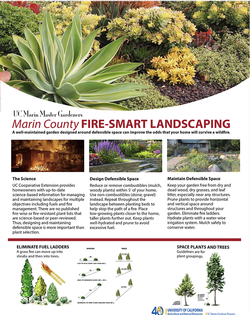Plan Your Fire-smart Landscape
> Three zones of defensible space
> Guidelines for plant spacing
> Woodpiles, decks, tanks, & other fire hazards
> Choosing plants for a fire-smart landscape
> Fighting fire on a slope
> Fire-smart home landscape design examples
Planning: Three zones of defensible space
To create defensible space, think about your garden in three zones. Generally speaking, fire-smart landscapes have no combustibles within five feet of the home, lower plants closer to the home, larger plants and trees further away from the home, and areas of non-combustible materials in between.
ZONE 0: 0 to 5 feet from house
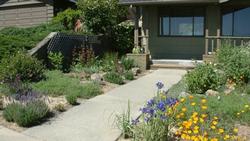
Greatest hazard: plants against combustible siding and under or near windows or doors. Flames can ignite surfaces behind siding if allowed to enter at vulnerable points such as vents or any gaps close to the foundation. Flames rise 2 to 3 times the height of flammable surfaces.
YES:
- Sparsely planted, low-growing, non-woody, herbaceous plants less than 18 inches tall (recommended). This may include vegetables, succulents, grasses, groundcover, seasonal flowering annuals, or lawn (and walkable lawn alternatives). (keep grass trimmed to less than one inch tall.)
- Non-combustible materials such as concrete, brick, pavers, decomposed granite, or gravel mulch.
NO:
- No branches within 10 feet of chimney
- No climbing plants
- No litter in roof gutters
- No combustible items under decks
- No combustible containers, mulch, fencing, furniture, firewood, tanks: Learn more about locating these and other combustibles.
- No combustible landscape items attached to house, including wood gates, fences, arbors, and trellises
MAINTENANCE is critical.
ZONE 1: 5 to 30 feet from house
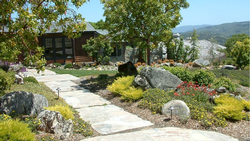
- Plant low, well-irrigated plants like vegetables, succulents, grasses, groundcover, seasonal flowering annuals, or lawn (and walkable lawn alternatives) close to the house and larger shrubs and trees further away from the house.
- Use non-combustible materials for walkways, such as gravel, brick, or decomposed granite.
- Break up mulched areas with hardscape material such as gravel or stone. Learn how to choose and use mulch in zone 1.
- Move firewood, lumber, and other common landscape items outside Zone 1.
- Allow ample plant spacing.
- Maintenance is critical.
- If budget allows, consider adding a small water feature or patio in this zone.
- If this zone extends into a neighbor’s yard, work together to coordinate actions and enhance the value of the collected efforts.
ZONE 2: 30 to 100+ feet from house and out to property line
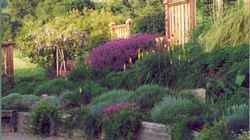
This is a transition zone on larger lots. It is the space between manicured gardens adjacent to the house and fringe areas abutting open space or between groups of houses surrounded by open space.
- Plants farthest from the house may not need to be irrigated, but they should be well maintained. California native plants with low water needs may be a good choice.
- Move anything burnable during a nearby wildfire 30 feet away from structures. This includes patio furniture and BBQ propane tanks.
- Wood mulch is acceptable in this zone. Learn more about how to choose and use mulch in zone 2.
- Allow ample plant spacing.
- Work with neighbors to create continuity between actions and increase defensible space where possible.
Fire-smart Guidelines For Spacing Plants
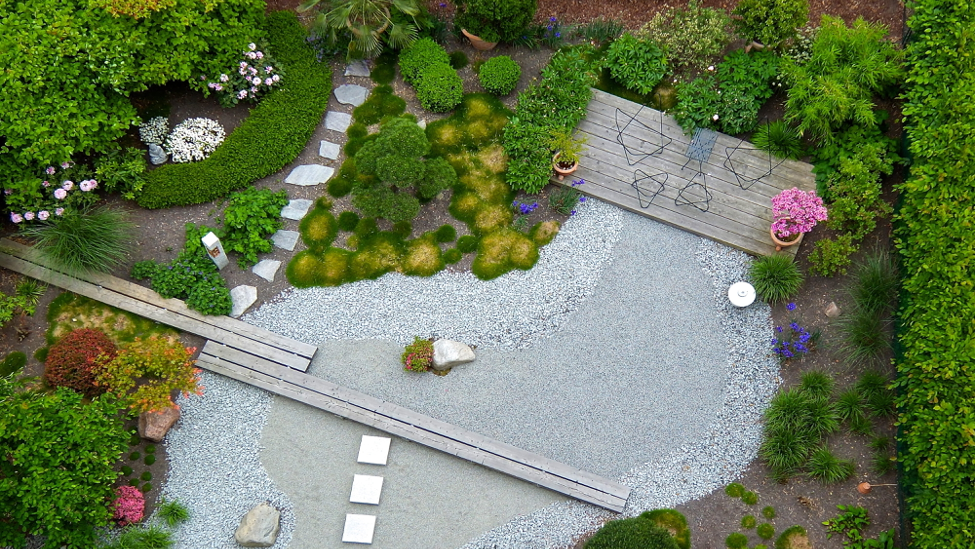
Just as the three zones of defensive space define a fire-smart landscape, so do the placement of plants and other combustible materials within each of the zones. The following guidelines are critical components to achieving maximum defensible space.
- Provide vertical and horizontal space between shrubs and trees, especially on slopes, to avoid fire ladders (taller plants catching fire from nearby lower plants). The steeper the slope, the more widely plants should be spaced.
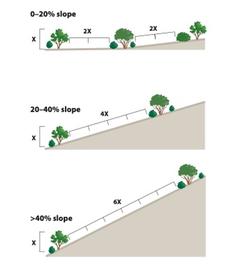
- Leave space between plant groupings with non-combustible surface areas like stone, gravel paths and other non-combustible, permeable materials to slow down the path of a fire and to allow easy access for maintenance.
- Avoid planting trees and shrubs in rows or hedges that provide an uninterrupted path for fire.
- Trim tall trees to remove limbs 6 ft to 10 ft from the ground, or up to one-third of their height
- Avoid massing shrubs at the base of trees or adjacent to structures, especially under eaves, overhangs, windows or decks.
- Limb up lower branches of younger trees over time but keep at least two-thirds of the total height in foliage. Learn more about structural pruning for young trees.
- Remove branches within 10 feet of chimney. Consult an arborist to consider elimination of branches that overhang the roof to minimize plant debris but not to the detriment of the health of the tree.
Woodpiles, Decks, Tanks & More: Managing Common Garden Fire Hazards
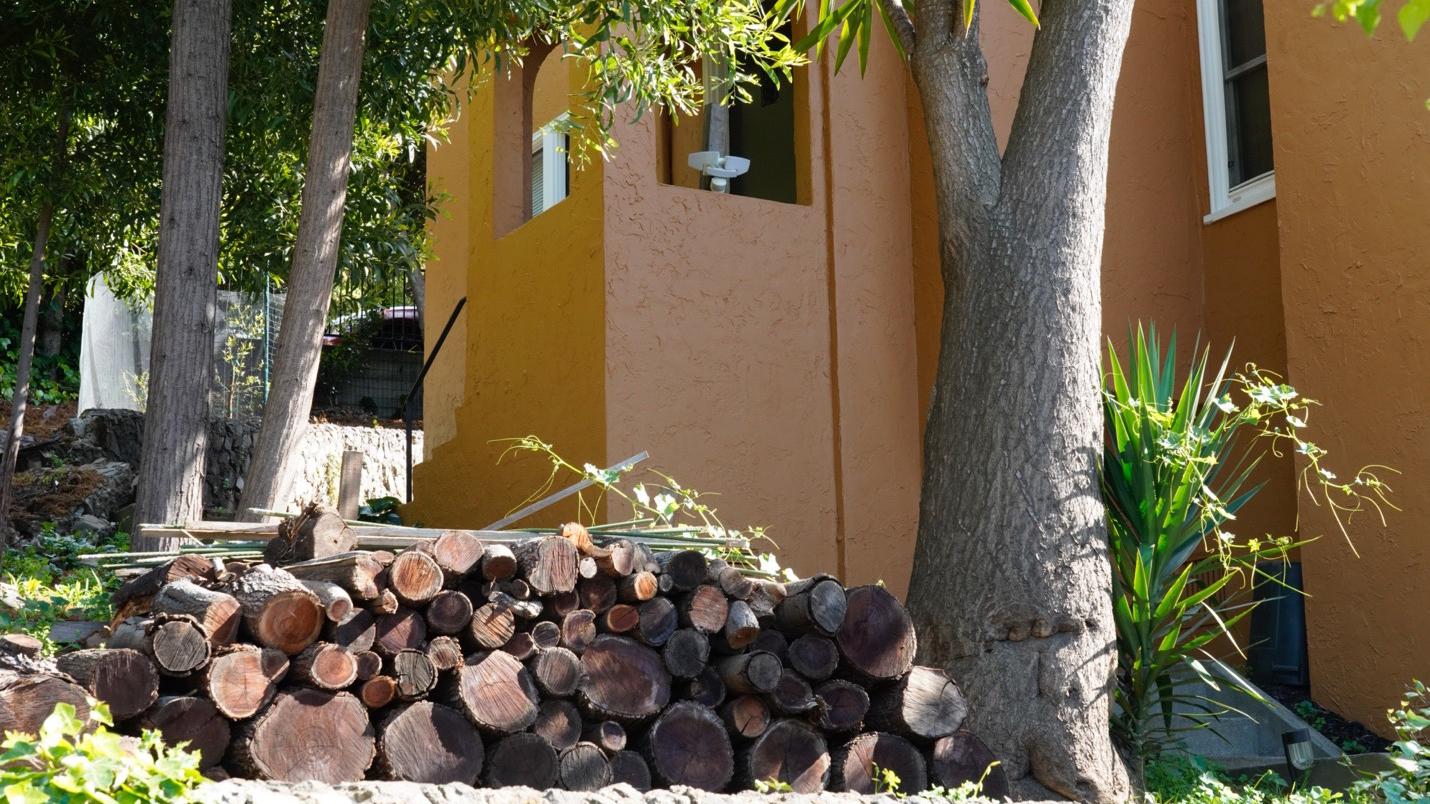
Plants are not the only items that need fire-smart attention in a landscape. Most gardens contain numerous combustible items that contribute fuel for fire and increase the risk when a wildfire burns. Here's how to manage common landscape items.
Woodpiles and lumber:
Stack at least 30 feet from any structures or store in non-combustible enclosure. Clear vegetation within 10 feet of woodpiles. (One cord of firewood contains 20 million BTUs of heat energy, the equivalent of 160 gallons of gasoline.) Store wood piles on soil or other non-combustible surfaces such as rock or concrete. Cover with a fire-retardant treated tarp or enclose in a noncombustible structure to avoid accumulation of vegetative debris that is easily ignited by embers.
Gasoline generators:
Keep 30 feet from any structure and 10 feet from plants.
Propane tanks:
Keep 30 feet from structures or enclose in non-combustible structure. Remove any flammable debris under propane tanks.
Wood trellises, gazebos, and sheds:
Build or relocate as far from the house as possible. Use fire-resistant construction materials and methods. For instance, trellises and gates can be metal, and roofs of gazebos and sheds should meet roofing standards for homes.
Underneath decks:
Screen or enclose areas below decks with wire mesh no larger than one-quarter inch, OR even better, attach skirting of ignition-resistant materials from the deck to the ground.
Plastic garbage and recycling bins:
Move away from house – the further away the better. Alternatively, store them inside a non-combustible enclosure such as a fiber-cement-clad structure.
Garden tools and brooms:
Do not lean them up against the house. Store in garage or shed or other secure area, preferably away from the house.
Patio furniture and cushions:
Move away from house during a nearby wildfire. Consider replacing with non-combustible option.
Jute or other natural fiber door mats:
Replace with non-combustible alternative or move them indoors when wildfire threatens.
Mulch:
See guidelines for choosing and using mulch.
Choosing Plants For a Fire-smart Landscape (It's Not What You Think)
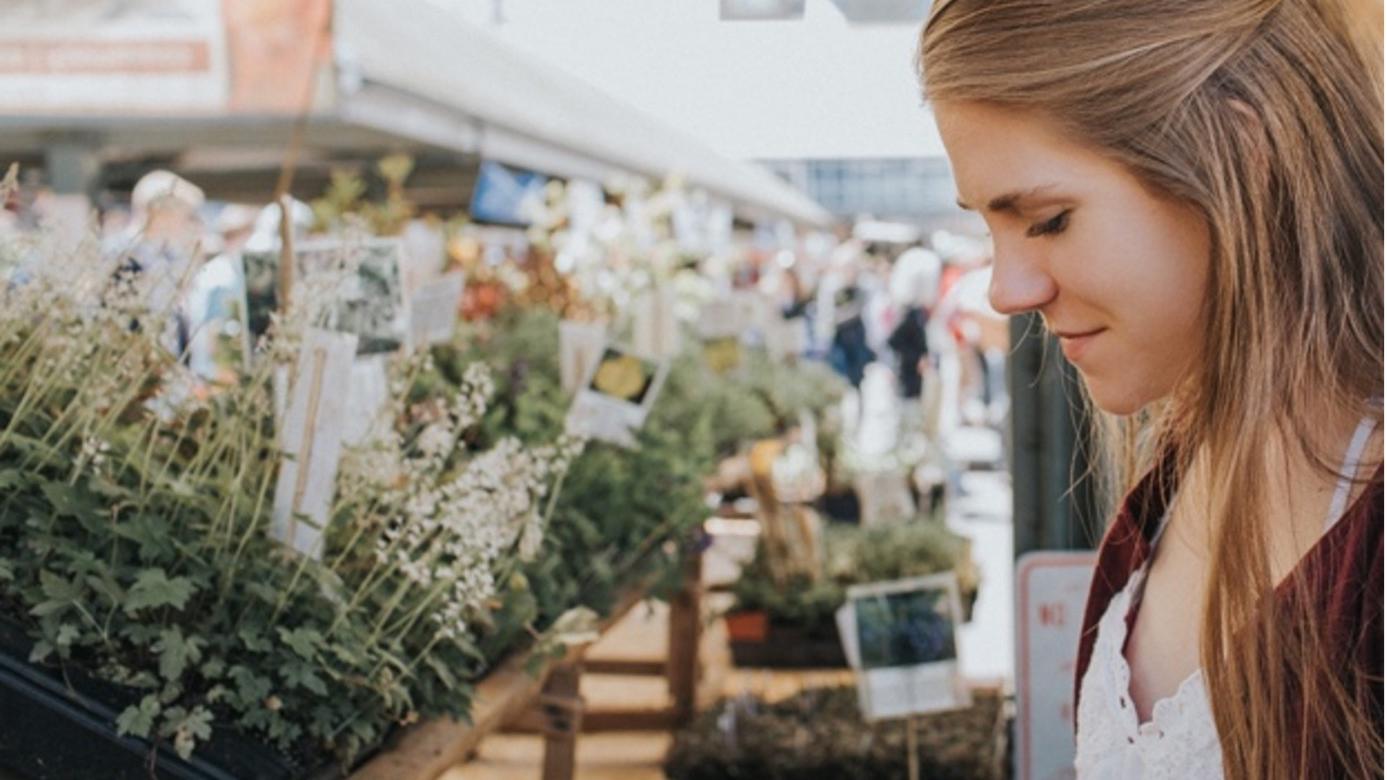
“When creating a fire-smart landscape, we advise homeowners to design defensible space and maintain their landscapes according to UC Marin Master Gardener guidelines. For a new or renovated landscape, consider California native or other pollinator-friendly plants that require little water and are easy to maintain. There are no published fire-wise or fire-resistant plant lists that are science-based or peer-reviewed. Design and maintenance are more important than plant selection.”
-- Steven Swain, UC Cooperative Extension Environmental Horticulture Advisor, Marin and Sonoma Counties
ALL PLANTS BURN. It is much more important to consider where a plant is situated and how it is maintained than to assume some plants are “better” than others. Choose plants and trees that meet your garden's cultural conditions and benefit the greater surroundings. Then use the three zones of defensible space guidelines to determine where to grow them.
Choosing native and other pollinator-friendly, water-wise plants is a core tenant of an Earth-friendly garden. Thoughtful plant selection and siting can reduce the threat of wildfire, cut maintenance costs, and help reduce the growing problem of excess fuel loads not only on your property, but in your neighborhood as well. Informed plant selection also leads to healthier plants, which are more fire-resistant than plants struggling to survive.
Rather than focus on individual plant species, consider growth habits and plant characteristics. In general, avoid plants and trees that:
- Produce excessive dead, dry, or fine debris that can become fuel for fire. This includes needles, leaves, fronds, dry bark, and other plant debris.
- Tend to build up dead thatch inside or under a green surface layer
Fighting Fire on a Slope: Special Considerations
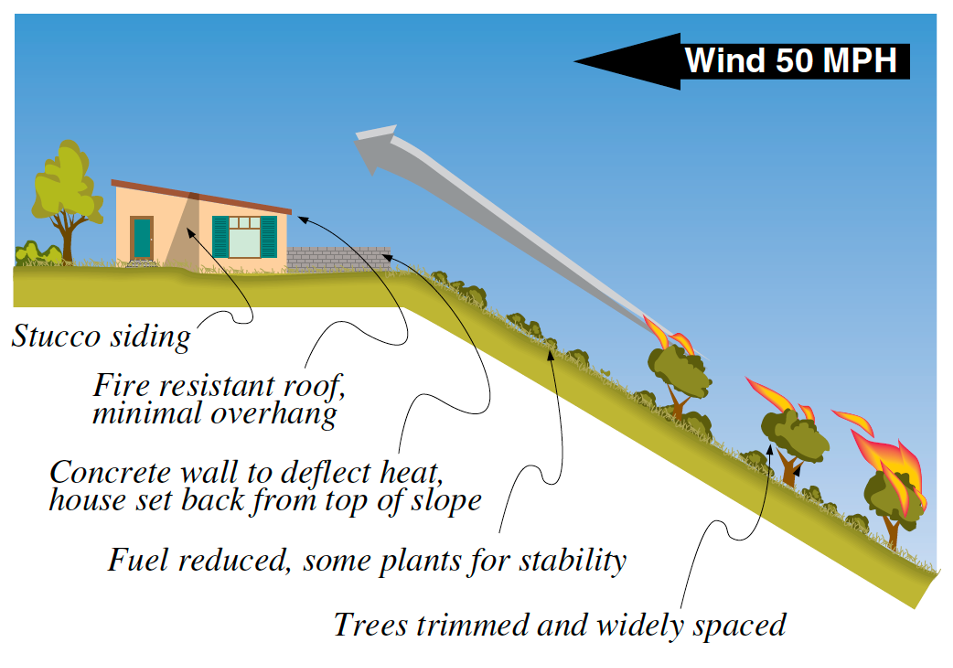
Strategies for homes on hillsides
Fire tends to travel fastest uphill by preheating dried vegetation from below and making it easier to ignite. The steeper the slope, the faster a fire will spread. Narrow canyons and saddles act as chimneys that trap heat, channel wind, and create erratic fire behavior. Ridges are also fire-prone. Heavily vegetated slopes are particularly hazardous. If you live on a slope in a canyon or on a ridge, consider the following:
If there is horizontal space between the slope and your home, consider constructing a stone or concrete wall between your house and the most likely path of approaching fire to help keep flames, heat, and burning embers away from the house. This is also a good place to install a lawn, pool, or patio of non-flammable materials such as concrete, brick, or stone.
Vegetation on slopes should be low in both height and volume, but it should not be completely eliminated because bare slopes may be subject to erosion and instability. Remove dead trees and shrubs, leaving the roots in place, if practical. Work with your local fire agency to help eradicate invasive plants, which increase the threat of fire and cause other environmental problems.
On slopes, plant widely-spaced, deep-rooted shrubs to help control erosion. Intersperse these plants with mulch or low-growing groundcovers. Learn more about gardening on a hillside and choose plants that help control erosion.
Use retaining walls to reduce the steepness of slopes below the house. This may slow the spread of fire and also help to prevent erosion and slope instability.


